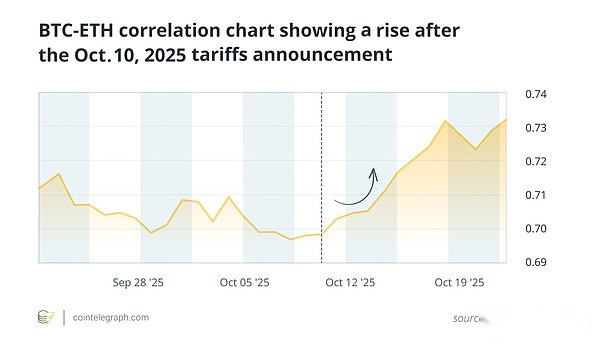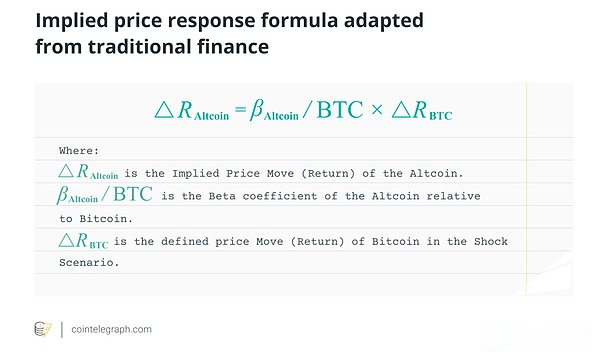
Author: Liza Savenko, Source: Cointelegraph, Compiler: Shaw Bitcoin Vision
Summary of key points:
-
Sharp declines in Bitcoin tend to trigger systemic contagion, pulling down the prices of other cryptocurrencies through liquidity and confidence channels.
-
During the crisis, markets tended to view cryptocurrencies as single risk assets rather than valuing their individual utility, as shown by the high correlation between BTC-ETH and BTC-XRP.
-
Correlation and beta coefficient analysis are crucial in quantifying how dependent Ethereum and XRP are on Bitcoin’s performance.
-
Monitoring correlation indicators, using derivatives and holding stable or income-producing assets can help hedge against Bitcoin-related shocks.
Bitcoin’s dominance of the cryptocurrency market has been a defining feature of cryptocurrency cycles.But what happens if Bitcoin’s dominance wanes or the price plummets by 50%?In this case, the next two largest cryptocurrencies by market capitalization – Ethereum (ETH) and Ripple (XRP) – will become a key case test of how the market can reorganize.
This article will explain how to evaluate Ethereum and XRP when Bitcoin takes a hit, including measuring dependencies, assessing risks, and developing effective hedging strategies.
Why Bitcoin Dominance Is So Important
In the traditional stock market, when an industry giant encounters a setback, the ripple effects will be immediate.Smaller companies tend to lose value as a result, as they rely on the ecosystem, investor confidence, supply chain connections and reputation of industry leaders.The same thing applies to the cryptocurrency market: Bitcoin plays the role of an “anchored asset.”When Bitcoin prices fall, the entire market loses stability and direction.
Historically, Bitcoin has accounted for a large share of the cryptocurrency market capitalization, which is known as a “dominance” metric.Most altcoins, including Ethereum and XRP, show strong correlation with Bitcoin’s price action.
For example, after the tariff announcement on October 10, 2025, the cryptocurrency market experienced a massive liquidation event and the price of Bitcoin dropped significantly.Over the next eight days, the BTC-ETH correlation rose from 0.69 to 0.73, while the BTC-XRP correlation also rose from 0.75 to 0.77, according to CoinMetrics data.
This remarkable convergence suggests that altcoins are not decoupling due to their respective utility during liquidity crises caused by macroeconomic panics.Metrics such as Ethereum’s transaction volume or XRP’s institutional adoption offer little protection in this scenario.
In contrast, a high positive correlation can serve as an empirical measure of systemic risk sharing.It shows that the market views the entire cryptocurrency industry as a single asset class.This will amplify the subsequent impact of the Bitcoin price collapse on Ethereum and XRP.

What this means: If Bitcoin’s market share declines or its price collapses, it’s unlikely that Ethereum and XRP will move independently of each other.They may be affected by:
Liquidity/Structural Channels
Market structures related to Bitcoin, including derivatives, trading flows and investor behavior, are weakening.A major collapse in Bitcoin could trigger a massive liquidation, with margin calls and chain selling being the main causes of such liquidation.This often results in huge outflows, affecting all crypto assets regardless of their fundamentals.The reason they fell is simply because they share the same basket of risks.
emotional channel
The collapse of decentralized assets has shaken the entire cryptocurrency industry to its core and eroded investor confidence in the long-term viability of cryptocurrencies.As panic spreads, investors tend to turn to safer assets such as fiat currencies or gold.The result is that the bear market continues for a long time, further reducing investor enthusiasm for Ethereum and XRP.
How to measure dependence and risk on Bitcoin
Step 1: Define shock scenarios
The analysis begins by selecting a Bitcoin event that may occur and have a huge impact.This could include defining a specific price shock, such as Bitcoin falling 50% in 30 days, or a structural shift, such as Bitcoin’s market share falling from 60% to 40%.
Step 2: Quantify dependencies
The next step is to calculate the current Pearson correlation coefficient between Ethereum, XRP, and Bitcoin.This statistic reflects the linear relationship between the daily returns of these assets, providing a benchmark for measuring the dependence between them.The closer the correlation coefficient is to +1, the stronger the correlation between the performance of the altcoin and Bitcoin.

Step 3: Estimate the immediate price response
Using correlation data, regression analysis is applied to calculate the beta coefficient of each altcoin relative to Bitcoin.The beta coefficient estimates the expected price change of an altcoin for every unit change in Bitcoin.This is similar to calculating a stock’s beta relative to a benchmark index such as the S&P 500 in traditional finance.
For example, if Ethereum has a beta value of 1.1 against Bitcoin, and the defined scenario assumes a 50% decline in Bitcoin, the implied Ethereum move would be -55% (1.1 × -50%).

Step 4: Adjust for liquidity risk and structural risk
Adjusting strategies needs to go beyond simple beta coefficient calculations to take into account key market structural risks.Exchange order books with lower trading volumes should be analyzed to assess liquidity risks, while structural risks and potential cascading liquidation risks of high derivatives open interest must be assessed.
For example, if the -55% drawdown implied in step 3 is exacerbated by illiquidity, the actual loss incurred may increase by another 10%, bringing the total drawdown to -65%.Additionally, open interest and margin positions should be reviewed, as high leverage can accelerate declines through cascading liquidations.
If Bitcoin takes a big hit, what happens to Ethereum and XRP?
In traditional finance, a plunge in the S&P 500 or the sudden collapse of a large brokerage often triggers a rapid and indiscriminate risk aversion—an effect known as “financial contagion.”Cryptocurrency markets are exhibiting similar dynamics, but faster and on a larger scale, often triggered by Bitcoin-induced shocks.
Data from past crises, including the FTX and Terra crashes, reveals a clear pattern: when Bitcoin falls, other cryptocurrencies usually follow.Bitcoin remains the market’s leading risk indicator.
In such cases, liquidity tends to flow into stablecoins or exit the market entirely to avoid the risk of volatile assets.While Ethereum benefits from its strong Layer-1 utility, it is not completely immune; its correlation with Bitcoin typically strengthens during periods of market stress as institutional capital views both as risk assets.However, Ethereum’s staking-locking mechanism and broad decentralized application ecosystem may provide a utility-driven backstop, helping it rebound more quickly after the crisis subsides.
On the other hand, assets like XRP may be disproportionately affected due to their higher regulatory and structural risks and lack of Ethereum’s extensive and natural on-chain revenue mechanism.Such shocks often trigger a vicious cycle in which the collective loss of confidence exceeds the underlying utility of the token, leading to an associated decline in the entire market.
How to hedge your strategy if Bitcoin loses market dominance or falls in price?
To hedge against the risk of a Bitcoin plunge, it’s not enough to rely on basic diversification.Systemic shocks demonstrate that extreme correlations tend to offset the benefits of risk diversification.
Explore derivatives
During periods of extreme market panic, futures market prices can be significantly lower than spot prices.This provides experienced traders with the opportunity to engage in relatively low-risk, non-directional arbitrage.They exploit market inefficiencies to hedge volatility risk rather than taking on directional price risk.
Diversify your portfolio with risk buffers
Hold tokenized gold, real world assets (RWA), or fiat-backed stablecoins to preserve and grow value.These assets serve as a reserve of liquidity when cryptocurrency markets plummet.
Monitor dominance and correlation ratios
Tracking Ethereum and XRP’s rolling short-term correlation with Bitcoin can serve as a real-time early warning sign that the benefits of diversification investing are disappearing.It identifies when immediate hedging action is needed.
Rebalance to income-producing positions
Move some of your assets into staking, lending, or liquidity pools that can generate income regardless of market direction.Stable earnings help offset valuation losses and increase asset recovery potential.





